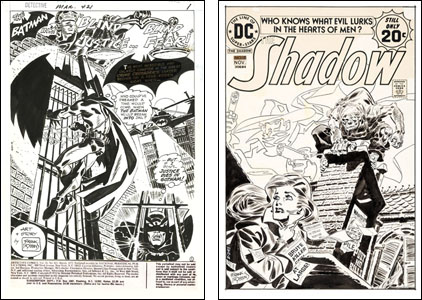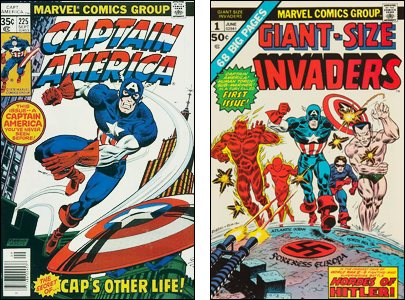If you haven't read Part 1 yet, read it before you read Part 2. This is Part 2…

Comic book readers today seem to be more tolerant than fans in the seventies of seeing their favorite heroes rendered in a variety of styles and interpretations. Back then, some readers were outraged if a Batman story wasn't drawn by Neal Adams or at least by someone trying to draw like Neal Adams. Frank Robbins wasn't at all of that school.
I thought his work was wonderful and I recall his fellow professionals like Alex Toth, Jack Kirby and Gil Kane praising it to the heavens. Some readers though are still, more than a half-century later, angry about it. He did a few issues of The Shadow also when Mike Kaluta left that book and there's a guy on Facebook who is still hating on those issues and thinks (I guess) that someone should have forced Kaluta at gunpoint to stay on the project.

Robbins worked for DC until 1975 when he jumped to Marvel full-time. DC was not buying enough material from him or paying him that well at a time when Marvel was desperate for artists who could pencil super-hero comics. The parent corporation was demanding more and more such books and the editorial side of the firm simply didn't have the manpower to competently produce all the comics that the business side was demanding.
John Romita (Senior) was then the Art Director at Marvel. If you felt qualified to draw for Marvel, you took your samples to him and he'd look them over and give you a solid critique. More than nine times out of ten, he'd say "You aren't quite ready yet" and recommend books and artists to study. Then he'd tell you to come back in a year and maybe by then they could start you on some unimportant back-up feature. One time when I visited John, he told me about a kid who'd come in six weeks earlier and been told that: Come back in a year.
The kid didn't come back in a year. He came back a few weeks later when Marvel called. They were so seriously in need of pencilers that they'd offered him not an unimportant back-up feature but a major book. Mr. Romita told me this story by way of explaining why, admittedly, some of the art in the comics being produced was not up to the standard he would have liked to have maintained. (No, don't write and ask me who the kid was. He did eventually turn into a pretty good artist worthy of the job. He just wasn't, in John Romita's estimation, good enough to be drawing the book he was drawing then.)
That was the situation at that company when Robbins inquired as to whether they could make use of his services. Marvel instantly wanted him…not for writing (they had plenty of writers) and not even for inking his own work. They needed comics penciled so they asked him what his page rate at DC was. Committing a bit of dishonesty that most freelancers commit at one time or another, Robbins fibbed and said he was getting more than he actually was.
Marvel instantly agreed to give him a slight increase on the fibbed rate to lure him over. For a few months, his work appeared in both companies' books, then Marvel offered him another slight increase to be exclusive to them in comic books and to pencil two books a month for them. He did not ink any of his Marvel assignments. As you'll hear in Part 3, he would have liked to but it better served the company's needs for Robbins to pencil two comics a month rather than to pencil-and-ink one.
By this point, his income from the Johnny Hazard newspaper strip had slipped such that Robbins knew its demise was not far off. He was also thinking about retirement in the not-too-distant future. He wanted to get away from comic strips and comic books. He wanted to spend his days painting what he wanted to paint at the pace at which he wanted to paint it. Retiring to a home in Mexico seemed like an attainable fantasy if he could amass some money quickly. Towards that goal, he took the Marvel offer.
Some artists would have struggled to pencil two comics a month even if that was all they were doing. Robbins continued to write and draw Johnny Hazard while penciling the two comics a month for Marvel. One of them was usually an issue of a new comic called The Invaders written by Roy Thomas. Roy was running the editorial division at Marvel at the time so he could easily have replaced his penciler if he didn't like what Robbins did but as it turned out, he loved what Robbins handed in.
The Invaders featured Marvel Super-Heroes in World War II and a lot of fans thought it was a great comic in every way. Others felt it was a great comic except for the artwork. He also during his stay at Marvel drew for Captain America, Daredevil, Ghost Rider, The Human Fly, The Man From Atlantis and a few others.
At some point in this scenario — I can't place precisely when — someone at Marvel figured out or learned about Robbins' fib about his DC page rate and similar fibs by others moving between companies. There was a squabble that does not seem to have directly involved Frank. It did involve Roy Thomas, who as I mentioned was Marvel's editor-in-chief.
As Roy tells the story, he was ordered to check with DC whenever a freelancer quoted a page rate there and he was to comply if DC called to check on a freelancer who might have been fibbing to them about his Marvel rate. Roy felt this kind of cooperation was illegal and refused to go along with the practice. The squabble ended with him stepping down as editor-in-chief at Marvel but continuing to work for them as an editor on books he wrote, including The Invaders.
Roy and the other writers who worked with Robbins seem to have loved the experience. Most of these comics were done "Marvel Method" with the penciler involved, sometimes heavily, in the plotting of the stories. Being a fine writer himself, Robbins was very useful in this regard.
Tony Isabella, who wrote a number of stories Robbins drew told me…
Frank wanted panel-by-panel plots and I gave them to him. Then he would go over them with me panel by panel and would come up with great ideas we could put into the stories. We got so much in rhythm with each other than he would place the word balloons and captions before I even wrote them and his choices were always impeccable. On one Ghost Rider story we did, he reconstructed a whole scene with airplanes so it made a lot more sense.
I don't believe Robbins was best-suited to draw costumed super-heroes. His figures were somewhat rubbery and the whole impact was a bit more on the cartoony side than some readers liked…but in The Invaders, he probably captured the mood of the time period better than anyone else Marvel then had available. It didn't help that others were inking his work and in some cases, I thought there were some especially bad match-ups of penciler and inker.
As you might have read on this blog before, I believe the number one cause of poor comic books over the years has been Bad Casting. A lack of talent or even initiative in some writers and artists has also been a factor and there are a few others…but I think Numero Uno has been putting together a mix of series, writer and artist(s) who were just plain wrong for each other. The writer didn't have a feel for the material. The artist didn't either and was maybe a bad match for the writer and his/her approach. If the artist didn't ink his or her pencil art, the wrong artist did. Sometimes, even the colorist or the letterer were miscast.
I was once offered the Star Trek comic book to write…why, I have no idea. I've never been a fan of the property in any form. If I'd needed work and that was the only thing available to me, I might have taken it. I might have had to.
Folks who worked in comics in the first half-dozen decades of the industry often didn't have much say in where those with hiring power wanted to place them…or who else would be working on those issues. Mike Sekowsky — who was high among the most misassigned artists of his generation in my opinion — once said to me, "I sometimes feel like a chess piece being moved around the board by some guy with no strategy at all."
If I'd written the Star Trek comic book, the scripts would have been rotten. And if by chance you're sitting there thinking, "Everything you ever wrote, Evanier, was rotten," then trust me on this: My Star Trek work would have been even rottener. And the comic could have been rottener still with the wrong artist(s).
That said, I think a lot of what Robbins drew for comics in the seventies was wonderful. He was expert at the aspect of drawing a comic book that Jack Kirby often said was the single-most important thing about drawing comics: Figuring out exactly what to draw in each panel and from what angle. To Jack, it didn't matter how pretty that picture was if it was the wrong picture to "tell" the story.
I think Robbins always drew the right picture but sometimes the heroes' bodies looked a bit odd. If Marvel could have deployed him on some other kind of comic that might not have been a problem. Or if the heroic figures of someone like John Buscema had not been the accepted norm at the time, we might not now see as much Facebook hating of artists like Frank Robbins.
Or if they'd let him ink his own work. Some artists — Joe Kubert, Doug Wildey, Dan Spiegle and several others come to mind — were never at their best when the company assigned them to only do part of the task of drawing.
